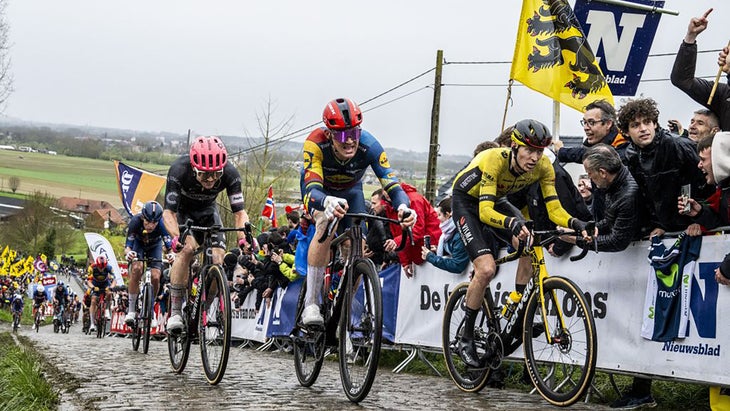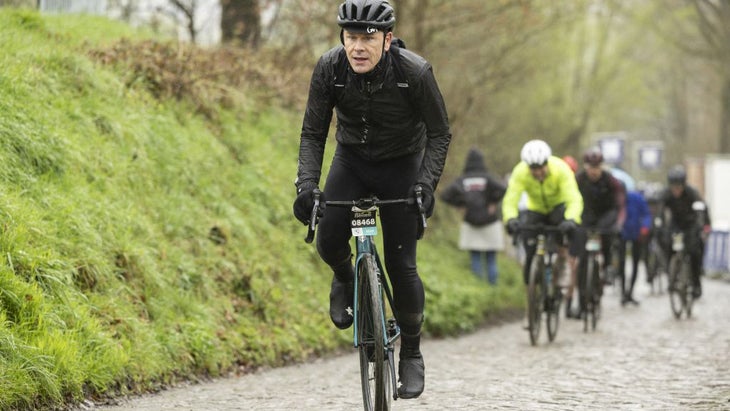
Back when I was a cycling journalist, I prepared myself to answer the same question whenever I encountered a fellow American bike nerd.
What’s your favorite bike race?
Most people assumed that I’d say the Tour de France. But my answer was always the same: the Tour of Flanders.
That’s right, Belgium’s Tour of Flanders, which will commence this Sunday, April 6, is cycling’s best race. It’s my favorite race to watch on TV and to attend in person.
Unlike the three-week Tour de France, the Tour of Flanders is just one day. It is one of the sport’s five so-called Monument races, which is a title reserved for road cycling’s oldest and hardest one-day events. These events—Milano-Sanremo, Tour of Flanders, Paris-Roubaix, Liege-Bastogne-Liege, and Il Lombardia—all boast courses that are 150 miles or longer.
The racing at the Tour of Flanders is breakneck and aggressive for 167 miles. The route is laden with razor-sharp cobblestones and steep, punishing climbs. And almost every year, the race produces drama all the way to the finish line. Once the Tour of Flanders starts, you don’t want to look away from the livestream.
As awesome as the Tour of Flanders is to watch on TV, it’s even cooler to check out in person. And anyone who loves traveling to bike races should put the Tour of Flanders atop your bucket list. Here’s why:
In Flanders, Belgium’s northern Flemish-speaking region, the race is equal parts patriotic celebration, day-long party, and professional sporting event. It’s like combining the Super Bowl with a Fourth of July parade, and adding gallons of heavy Trappist ale. Millions of Flemish people leave their homes to stand alongside the roads and party. People wave the yellow Lion of Flanders flag and generally goes bananas whenever the cyclists ride by. The whole scene absolutely slaps.
My affection for the Tour of Flanders starts with the racecourse. The route zigzags its way across the Flemish countryside before completing two laps on a hilly circuit outside the town of Oudenaarde. The circuitous route is way more spectator-friendly than the Tour de France course. While fans at the Tour de France wait by the roadside for hours to see the peloton buzz by in a flash, at Flanders, you can see the riders speed by multiple times on race day.

There’s a men’s and a women’s pro races both tackle the same approximate route on the same day. Fans who attend get to see cyclists whizz by all day long.
I also love the race’s topography. Make no mistake: there are no soaring Alpine or Pyrenean ascents in Flanders. Instead, the pastoral countryside is dotted with short but punchy hills. The roads up these mounds are steep, no wider than a sidewalk, and are made of cobblestones. Riding a stiff carbon bicycle over a European cobblestone street is extremely painful and jarring.
When the pro peloton hits these narrow and uncomfortably bumpy lanes, chaos ensues, and cyclists jostle for position while generating eye-popping amounts of power. When it rains, the cobblestones become extremely slippery, and riders must sometimes dismount and walk.
Il existe un Koppenberg à Zurich ? pic.twitter.com/SqTJWvsRQV
—
ntoine VAYER
(@festinaboy) September 22, 2024
I cannot stress how important these tiny hillsides are to the Flemish, who revere them much like Americans love Mount Rainier or Denali. Seemingly innocuous hillsides like the Koppenberg, Paterberg, or Oude Kwaremont are steeped in the race’s 112-year history, and have been the site of legendary battles for generations.
The third reason I love the Tour of Flanders is the way these climbs fuel the action. The race’s ebb-and-flow is must-watch TV for any fan of bike racing. Since it’s a one-day race, and not a stage race like the Tour de France, the cyclists are racing for that day’s victory only. Each hill breaks the peloton into smaller groups, but the gaps between these groups are small, which creates a constant cat-and-mouse dynamic as the action unfolds.
The very best racers wait until the final 40 miles or so to attack, and drama always ensues when the top riders square off on the Oude Kwaremont and Paterberg. Oftentimes, the crux of the race occurs when one cyclist can generate just a few more watts than his or her foe on one of these short climbs. He or she who wins Flanders is equal parts brains and brawn.
É amanhã! Tour de Flandres! #RVV24 #RVV #DeRonde #RondevanVlaanderen #Paterberg pic.twitter.com/NfJkNPu8Zl
— BikeBlz (@BikeBlz) March 30, 2024
And the cyclists who excel at the Tour of Flanders are—by and large—built differently from those who win the Tour. Grand Tours cater to spindly, ultralight cyclists who can ascend 3,000-foot mountain passes for days on end. At Flanders, the peloton’s big and brawny racers like Flemish hero Wout van Aert or Dutch racer Mathieu van der Poel get to shine.
But here’s perhaps the best reason to check out Flanders in person: you get to ride your own bike on the course. On the day before the professional race, organizers stage a mass-participant cyclosportive called We Ride Flanders on the same route. You can choose your own distance ride. Organizers position feed zones along the route where you can chow down on waffles and local chocolate.

Every year, approximately 16,000 cyclists head onto the narrow lanes crisscrossing Flanders and race each other up the Koppenberg, Paterberg, and other climbs. I’ve done We Ride Flanders on four separate occasions times, I can attest that it is chaotic and bonkers and unquestionably fun. You get to experience just how steep and painful the climbs are, which gives you an added appreciation when you see the peloton rumble up them a day later. You don’t get to do that at the Tour de France.
Plus, when you’re done with the amateur event, you can check out the Tour of Flanders museum in downtown Oudenaarde. You can also drink plenty of local beer and eat chocolate and cheese until you pass out.
I always tell cyclists to make the Tour of Flanders the focal point of a week-long or ten-day trip to Belgium. The weekend prior to Flanders is another major cobblestone race, called Gent-Wevelgem, which has its own amateur event. There’s a smaller race on the Wednesday between the two events, called Dwars Door Vlaanderen, which is always a compelling event to watch as well. And if you have oodles of vacation time to burn, you can then stick around another week and view Paris-Roubaix in nearby France.
I obviously understand the appeal of the experiencing the Tour de France, with its soaring Alps, picturesque towns, and summer sunshine. But take my word for it: the Tour of Flanders is better.
The post The Tour of Flanders Is Better than the Tour de France. Here’s Why. appeared first on Outside Online.
















